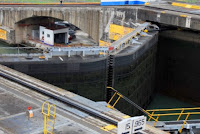
Oh, yes. They look like sticks of chewing gum. Maybe that’s why they are called sticks.

 Living la vida loca on the canal
Living la vida loca on the canal Locomotive and Happy operator
Locomotive and Happy operator Locomotive with some line handlers hitching a ride
Locomotive with some line handlers hitching a ride Rowing out for the lines for the ship.
Rowing out for the lines for the ship. Second series of locks
Second series of locks The locomotives use a cog system to trave forward and back
The locomotives use a cog system to trave forward and back Dawn on the Panama Canal
Dawn on the Panama Canal+5-7-2008+12-17-20+PM+3872x2592.JPG) Filled to the brim (notice the walkway across the top of the lock)
Filled to the brim (notice the walkway across the top of the lock)  Going through a lock as seen from the Pilot Deck. Our cargo in the foreground. Silver Lining being lifted in the chamber ahead of us.
Going through a lock as seen from the Pilot Deck. Our cargo in the foreground. Silver Lining being lifted in the chamber ahead of us. Life is tough here on the Canal
Life is tough here on the Canal A lock chamber
A lock chamber  A locomotive at work with two positioning cables
A locomotive at work with two positioning cables An example of how high the lift is
An example of how high the lift is  Canal at night
Canal at night Entering San Diego 4-27-2008 3-47-35 PM
Entering San Diego 4-27-2008 3-47-35 PM  Preparing to launch with the crew looking on 5-4-2008 1-22-31 AM
Preparing to launch with the crew looking on 5-4-2008 1-22-31 AM 
 Schoolgirls on Holiday in Nagasaki
Schoolgirls on Holiday in NagasakiDo I HAVE to do this

 Life imitating Art in Glover Garden
Life imitating Art in Glover Garden
 Old Port in Masan 4-6-2008 4-17-00 AM
Old Port in Masan 4-6-2008 4-17-00 AM
 I'm watching you 4-6-2008 2-59-37 AM
I'm watching you 4-6-2008 2-59-37 AM
Korean Fish Mongersette 4-6-2008 3-01-33 AM

One of the many advantages of visiting countries by sea is that we always have fresh fish available to us in the most of the restaurants. In Asia, at least in the costal areas, fish are kept alive in aerated fish tanks until they are prepared for consumption. We decided to visit the Masan fish market, in Korea, to learn more about how this is accomplished. Like most markets in the world we found rows of vendors displaying their wares, except that in this case, the wares were very much alive and swimming. Most of the vendors were female and we were greeted with smiles, broken English and much laughter. This is a place where everybody appears to be happy and there is a shared sense of camaraderie. Everywhere was spotlessly clean and the market had a wonderfully sweet smell of fresh fish. Live fish don’t have much of a fishy smell. I say fish, but actually there was an abundance of seafood too; crabs, oysters, shrimp, prawns, mussels, whelks, octopi and squid to name a few. There even was a lonesome frog for sale.
Water is piped in from the nearby harbor so that the water tanks can constantly be replenished. Open gutters, covered with grills, return the excess overflow. Open gutters paint a bad image, perhaps, but like the whole market, the water that flowed through these gutters was clean and sweet smelling. I suspect that the vendors have another method of disposal for their fish waste. A hint of one bad fish here could spell doom to the whole market.
So how do the fish get from here to their destination alive? I noticed that every vendor had stacks of Styrofoam boxes in every size. The large restaurant cooler sizes are filled with seawater and fish, and are delivered by truck. Smaller individual purchases are put in sealed plastic bags, similar to how a goldfish is transported in the U.S. Other fish are killed and wrapped and taken home for prompt consumption. Octopi and shell fish etc., which don’t need moving sea water to stay alive, are packed in crushed ice, of which there was plenty.
The fish market covers approximately five or six city blocks and there are stalls of spices and herbs, fruits and vegetables around the periphery to allow for the convenience of one-stop shopping. We arrived slightly before nine o’clock on a Sunday morning when the market was still quiet. We had no difficulty losing ourselves here for two and a half hours. This early in the morning the vendors had time to spare and enjoyed interacting with us. We were taught the correct Korean pronunciation for many of the fish. These lessons usually involved three or four vendors who insisted on being party to this activity, much to everybody’s enjoyment.
By the time we left the market was busy and we realized that we had been there at the best time of the day to allow for these fun filled interactions.
 At the Masan Fish Market. All thise fish are confusing 4-6-2008 2-55-42 AM
At the Masan Fish Market. All thise fish are confusing 4-6-2008 2-55-42 AM Our Korean Meal 4-5-2008 5-55-02 AM
Our Korean Meal 4-5-2008 5-55-02 AM